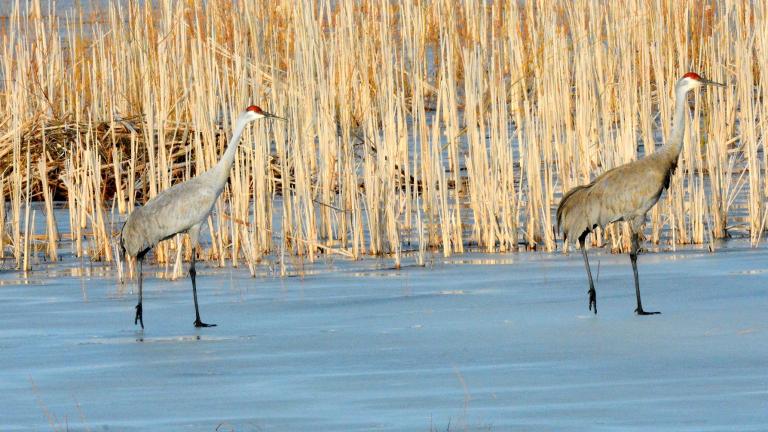Barring any 11th hour court decisions, the Greater Rockford Airport Authority will soon resume construction on its cargo expansion project, bulldozing a portion of ancient Bell Bowl Prairie in order to carve out a new roadway.
Airport officials recently received approval from the Federal Aviation Administration to move forward with an alternate version of their roadway plan, which will preserve 6.2 acres of prairie — 3.6 acres of high quality prairie and 2.6 acres of degraded prairie.
Any excavation must take place between Oct. 15 and March 15 to avoid impacts to the federally endangered rusty patched bumble bee, as well as several nesting bird species, the FAA said.
According to the Natural Land Institute — longtime stewards of Bell Bowl Prairie until the airport severed ties — the airport has informed the organization’s lawyers that construction will begin Thursday, March 9.
Rockford Airport officials did not immediately respond to a request for comment.
Natural Land Institute is now suing the FAA for authorizing the construction and plans to hold a rally on Wednesday at 5 p.m. at the Winnebago County Courthouse.
“We were expecting it, so we had our lawsuit ready,” said Kerry Leigh, executive director of Natural Land Institute.
How Did We Get Here?
Bell Bowl Prairie is part of the airport’s nearly 3,000-acre property, but it predates the airport by several millennia, carved by the retreat of the last glaciers. It has been identified as “outstanding” in the Illinois Natural Areas Inventory.
In August 2021, a birder spotted construction equipment approaching the prairie — the first Natural Land Institute was made aware of the airport’s expansion plan, which had been approved in 2018. An environmental assessment conducted in 2018 — deemed “flawed” by critics — found no endangered species present in the prairie.
The discovery of rusty patched bumble bees at Bell Bowl put a halt to the construction and triggered an additional review process.
The FAA has now completed its reevaluation of the original environmental assessment. The administration found that the changes to the roadway proposed by the airport are “consistent with existing national environmental policies and objectives.”
Included is permission to “take” — or destroy — plants such as the state-listed large-flowered beardtongue, plain’s sedge, cat’s claw and prairie dandelion. There’s no stated plan to save the plant’s roots for possible transplant elsewhere.
The National Environmental Policy Act mandates the environmental assessment. The FAA’s process is quite complicated, in that there are a lot of hoops to jump through to get approval for a project with environmental implications, said Amy Doll, director of Friends of Illinois Nature Preserves, one of many environmental organizations fighting to save Bell Bowl Prairie.
“But if you jump through the hoops," Doll said, "you can destroy nature.”
Based on the experience she’s gained over the last 18 months, Leigh said it’s time to revamp the environmental assessment process.
“What disturbs me and many others is that the environmental protections we’ve had since the ‘70s no longer serve us. The loss of habitat and biodiversity is stunning,” and 60-year-old laws haven’t kept pace with that reality, she said.
It’s not rigorous enough on the part of consulting agencies such as the Illinois Department of Natural Resources and U.S. Fish and Wildlife Service, and some of the requirements are all but obsolete, Leigh said.
There’s an outdated rule, for example, that calls for notice of an environmental assessment to be placed in a local newspaper. “Who reads the newspaper?” asked Leigh, especially back-page classifieds.
Now What?
Natural Land Institute is expecting a ruling Wednesday on its request for a stay, which could buy time until Oct. 15. Prairie supporters would use the reprieve to keep the pressure up on Gov. J.B. Pritzker, urging him to push the airport toward a roadway option that avoids the prairie.
There were alternatives on the table, Leigh said, that would have saved the entire prairie, but were rejected out of hand due to a single factor. Some of the workable elements of these alternatives could have been combined, she said, but instead, reviewing agencies took each one at face value, and considered them in a vaccuum.
"To me, it's just appalling and irresponsible on the part of the agencies," said Leigh.
With the FAA’s signature, the actions taken by the Rockford Airport may be legal, “but it is still wrong,” Natural Land Institute said in a statement.
“No mention is given to how the remaining bifurcated prairie will be harmed by a road severing it down the middle. No mention is made about how the irreplaceable soil, microbes, fungi, dormant plants and insects might be handled after they’re excavated,” the institute said. “Nor, for that matter, just ... why a cargo facility and road are more valuable to Rockford than one of the last ancient prairies left in Illinois.”
This article originally published on March 6. It has been updated with additional information.
Contact Patty Wetli: @pattywetli | (773) 509-5623 | [email protected]








